airbag LAND ROVER DISCOVERY 2002 Workshop Manual
[x] Cancel search | Manufacturer: LAND ROVER, Model Year: 2002, Model line: DISCOVERY, Model: LAND ROVER DISCOVERY 2002Pages: 1672, PDF Size: 46.1 MB
Page 19 of 1672

CONTENTS
16 CONTENTS
Brake system control component layout ......................................................................................... 70-1
Brake system control diagram ........................................................................................................ 70-2
Brake system hydraulic component layout ..................................................................................... 70-4
Description ...................................................................................................................................... 70-5
Operation ........................................................................................................................................ 70-20
DESCRIPTION AND OPERATION
Handbrake component layout ......................................................................................................... 70-25
Description ...................................................................................................................................... 70-26
ADJUSTMENTS
Handbrake .................................................................................................................................... 70-29
Brake system bleeding .................................................................................................................. 70-30
REPAIRS
Brake disc - front .......................................................................................................................... 70-33
Brake disc - rear ........................................................................................................................... 70-34
Master cylinder - brake ................................................................................................................. 70-35
Cable - handbrake ........................................................................................................................ 70-36
Switch - brake light ....................................................................................................................... 70-37
Brake pads - front ......................................................................................................................... 70-37
Brake pads - rear .......................................................................................................................... 70-38
Brake shoes - handbrake................................................................................................................ 70-39
Servo - brake .................................................................................................................................. 70-41
Vacuum pump - servo..................................................................................................................... 70-42
Housing - caliper - front ................................................................................................................ 70-43
Housing - caliper - rear ................................................................................................................. 70-44
ECU - Self levelling and anti locking brakes (SLABS) ................................................................. 70-45
Sensor – ABS – front ..................................................................................................................... 70-46
Sensor – ABS – rear ....................................................................................................................... 70-47
Modulator unit - ABS ...................................................................................................................... 70-47
Switch - Hill descent control............................................................................................................ 70-48
Switch - handbrake ....................................................................................................................... 70-49
RESTRAINT SYSTEMS ............................................................................ 75-1
DESCRIPTION AND OPERATION
SRS component layout ................................................................................................................... 75-1
SRS block diagram ......................................................................................................................... 75-2
Description - SRS ........................................................................................................................... 75-3
Operation - SRS ............................................................................................................................. 75-9
DESCRIPTION AND OPERATION
Description - seat belts ................................................................................................................... 75-11
REPAIRS
Seat belt - front .............................................................................................................................. 75-13
Seat belt - rear - centre ................................................................................................................. 75-13
Seat belt - rear - side .................................................................................................................... 75-15
Mounting - seat belt - 'B' post ...................................................................................................... 75-16
Seat belts - third row ....................................................................................................................... 75-17
Pre-tensioner - front seat belt ....................................................................................................... 75-18
Airbag module - drivers .................................................................................................................. 75-18
Airbag module - passenger ........................................................................................................... 75-19
DCU ................................................................................................................................................ 75-20
Rotary coupler ................................................................................................................................ 75-21
Airbag deployment tool - self test ................................................................................................... 75-22
Airbag module - drivers - deployment ............................................................................................. 75-23
Page 20 of 1672

CONTENTS
CONTENTS 17
Airbag module - passenger - deployment ...................................................................................... 75-25
Pre-tensioner - deployment ............................................................................................................. 75-27
DOORS ..................................................................................................... 76-1-1
REPAIRS
Door - front .................................................................................................................................... 76-1-1
Door - rear ..................................................................................................................................... 76-1-2
Door - tail ........................................................................................................................................ 76-1-3
Glass - front or rear door ............................................................................................................... 76-1-4
Quarter light ................................................................................................................................... 76-1-5
Regulator and motor - front and rear door glass .......................................................................... 76-1-6
Trim casing - front door .................................................................................................................. 76-1-7
Trim casing - rear door ................................................................................................................... 76-1-8
Trim casing - tail door .................................................................................................................... 76-1-9
Latch and motor - front door .......................................................................................................... 76-1-9
Latch and motor - rear door ........................................................................................................... 76-1-10
Latch and motor - tail door ............................................................................................................ 76-1-11
Handle - exterior - rear door .......................................................................................................... 76-1-12
Handle - exterior - tail door ........................................................................................................... 76-1-12
Handle - exterior - front door .......................................................................................................... 76-1-13
EXTERIOR FITTINGS ............................................................................... 76-2-1
REPAIRS
Wing - front - up to 03MY ................................................................................................................ 76-2-1
Wing - front - from 03MY ................................................................................................................. 76-2-2
Rear folding step ............................................................................................................................ 76-2-4
Liner - wheel arch - front ................................................................................................................. 76-2-5
Liner - wheel arch - rear ................................................................................................................. 76-2-5
Panel - underbelly .......................................................................................................................... 76-2-6
Mirror - exterior - electric ................................................................................................................ 76-2-7
Roof bars ....................................................................................................................................... 76-2-7
Bonnet ........................................................................................................................................... 76-2-8
Cable - bonnet release - up to 03MY .............................................................................................. 76-2-9
Cable - bonnet release - from 03MY ............................................................................................... 76-2-10
Bumper assembly - front ............................................................................................................... 76-2-11
Bumper assembly - rear - from 03MY ............................................................................................. 76-2-12
Trim finisher - bumper - front - from 03MY ...................................................................................... 76-2-14
Bumper assembly - rear - up to 03MY ............................................................................................ 76-2-14
Side finisher - windscreen .............................................................................................................. 76-2-15
Grille - front - up to 03MY................................................................................................................ 76-2-16
Grille - front - from 03MY ................................................................................................................ 76-2-16
INTERIOR TRIM COMPONENTS ............................................................. 76-3-1
REPAIRS
Trim casing - tail door speaker ...................................................................................................... 76-3-1
Trim casing - side - loadspace ....................................................................................................... 76-3-1
Trim casing - upper - 'B' post ......................................................................................................... 76-3-2
Trim casing - lower - 'B' post ......................................................................................................... 76-3-3
Page 40 of 1672

GENERAL INFORMATION
03-5
Electricity and heating:
lkeep doors and windows closed in the winter;
lswitch off machinery or lights when not needed;
luse energy efficient heating systems;
lswitch off computers and photocopiers when
not needed.
Fuel:
ldon't run engines unnecessarily;
lthink about whether journeys are necessary and
drive to conserve fuel.
Water:
ldon't leave taps and hose pipes running;
lmend leaks quickly, don't be wasteful.
Compressed air:
ldon't leave valves open;
lmend leaks quickly;
ldon't leave the compressor running when not
needed.
Use of environmentally damaging materials:
lcheck whether a less toxic material is available.
Handling and storage of materials:
lhave the correct facilities available for handling
liquids to prevent spillage and wastage as listed
above;
lprovide suitable locations for storage to prevent
frost damage or other deterioration.
Waste Management
One of the major ways that pollution can be reduced
is by the careful handling, storage and disposal of all
waste materials that occur on sites. Legislation
makes it illegal to dispose of waste materials other
than to licensed waste carriers and disposal sites.
This means that it is necessary to not only know what
the waste materials are, but also to have the
necessary documentation and licenses.
Handling and storage of waste
Ensure that waste materials are not poured down the
drain or onto soils. They should be stored in such a
way as to prevent the escape of the material to land,
water or air.
They must also be segregated into different types of
waste e.g. oil, metals, batteries, used vehicle
components. This will prevent any reaction between
different materials and assist in disposal.
Disposal of waste
Disposal of waste materials must only be to waste
carriers who are licensed to carry those particular
waste materials and all the necessary
documentation must be completed. The waste
carrier is responsible for ensuring that the waste is
taken to the correct disposal sites.Dispose of waste in accordance with the following
guidelines.
lFuel, hydraulic fluid, anti-freeze and oil: keep
separate and dispose of to specialist contractor.
lRefrigerant: collect in specialist equipment and
reuse.
lDetergents: safe to pour down the foul drain if
diluted.
lPaint, thinners: keep separate and dispose of
to specialist contractor.
lComponents: send back to supplier for
refurbishment, or disassemble and reuse any
suitable parts. Dispose of the remainder in
ordinary waste.
lSmall parts: reuse any suitable parts, dispose
of the remainder in ordinary waste.
lMetals: can be sold if kept separate from
general waste.
lTyres: keep separate and dispose of to
specialist contractor.
lPackaging: compact as much as possible and
dispose of in ordinary waste.
lAsbestos-containing: keep separate and
dispose of to specialist contractor.
lOily and fuel wastes (e.g. rags, used spill kit
material): keep separate and dispose of to
specialist contractor.
lAir filters: keep separate and dispose of to
specialist contractor.
lRubber/plastics: dispose of in ordinary waste.
lHoses: dispose of in ordinary waste.
lBatteries: keep separate and dispose of to
specialist contractor.
lAirbags - explosives: keep separate and
dispose of to specialist contractor.
lElectrical components: send back to supplier
for refurbishment, or disassemble and reuse
any suitable parts. Dispose of the remainder in
ordinary waste.
lElectronic components: send back to supplier
for refurbishment, or disassemble and reuse
any suitable parts. Dispose of the remainder in
ordinary waste.
lCatalysts: can be sold if kept separate from
general waste
lUsed spill-absorbing material: keep separate
and dispose of to specialist contractor.
lOffice waste: recycle paper and toner and ink
cartridges, dispose of the remainder in ordinary
waste.
Page 53 of 1672
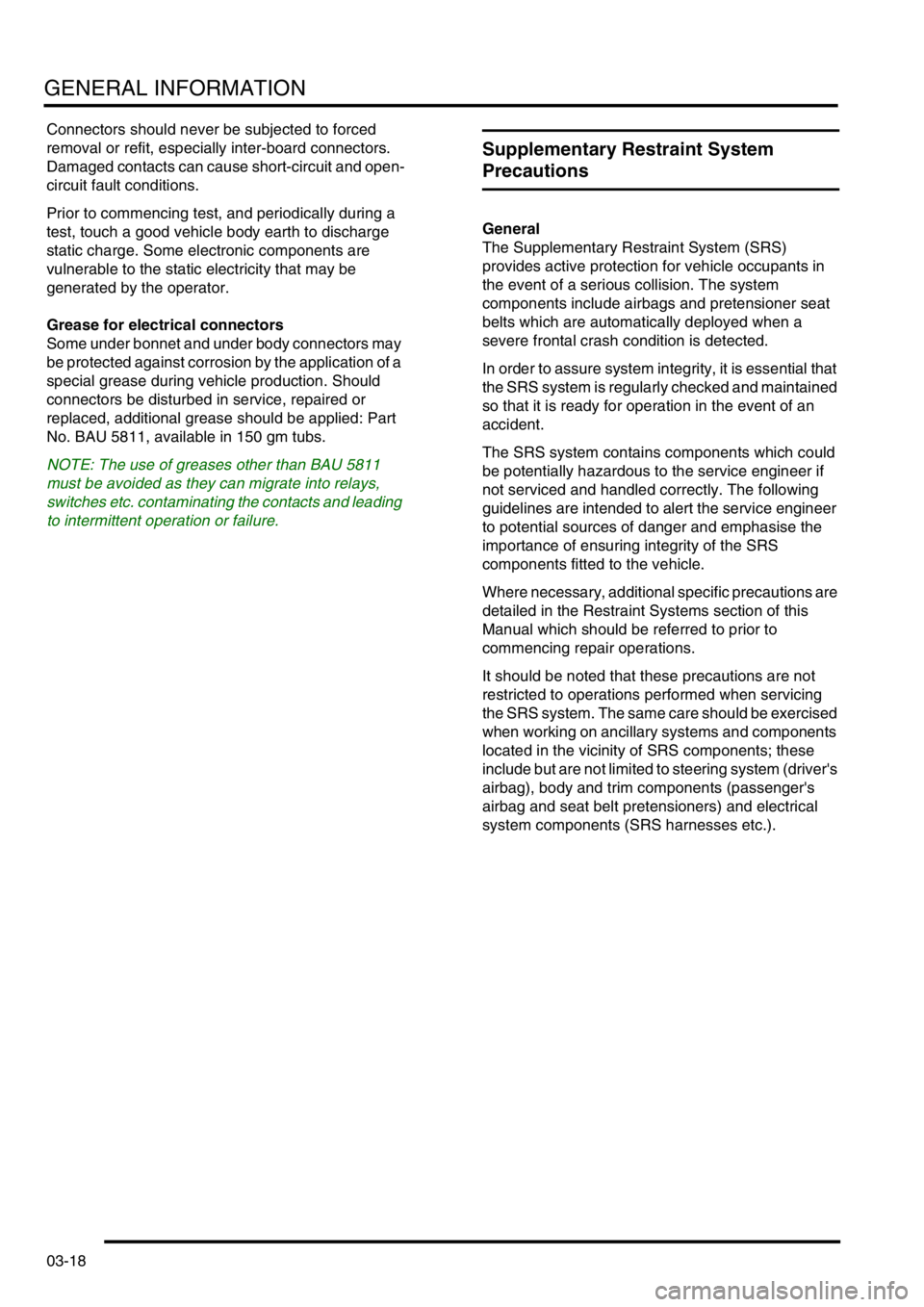
GENERAL INFORMATION
03-18
Connectors should never be subjected to forced
removal or refit, especially inter-board connectors.
Damaged contacts can cause short-circuit and open-
circuit fault conditions.
Prior to commencing test, and periodically during a
test, touch a good vehicle body earth to discharge
static charge. Some electronic components are
vulnerable to the static electricity that may be
generated by the operator.
Grease for electrical connectors
Some under bonnet and under body connectors may
be protected against corrosion by the application of a
special grease during vehicle production. Should
connectors be disturbed in service, repaired or
replaced, additional grease should be applied: Part
No. BAU 5811, available in 150 gm tubs.
NOTE: The use of greases other than BAU 5811
must be avoided as they can migrate into relays,
switches etc. contaminating the contacts and leading
to intermittent operation or failure.
Supplementary Restraint System
Precautions
General
The Supplementary Restraint System (SRS)
provides active protection for vehicle occupants in
the event of a serious collision. The system
components include airbags and pretensioner seat
belts which are automatically deployed when a
severe frontal crash condition is detected.
In order to assure system integrity, it is essential that
the SRS system is regularly checked and maintained
so that it is ready for operation in the event of an
accident.
The SRS system contains components which could
be potentially hazardous to the service engineer if
not serviced and handled correctly. The following
guidelines are intended to alert the service engineer
to potential sources of danger and emphasise the
importance of ensuring integrity of the SRS
components fitted to the vehicle.
Where necessary, additional specific precautions are
detailed in the Restraint Systems section of this
Manual which should be referred to prior to
commencing repair operations.
It should be noted that these precautions are not
restricted to operations performed when servicing
the SRS system. The same care should be exercised
when working on ancillary systems and components
located in the vicinity of SRS components; these
include but are not limited to steering system (driver's
airbag), body and trim components (passenger's
airbag and seat belt pretensioners) and electrical
system components (SRS harnesses etc.).
Page 54 of 1672
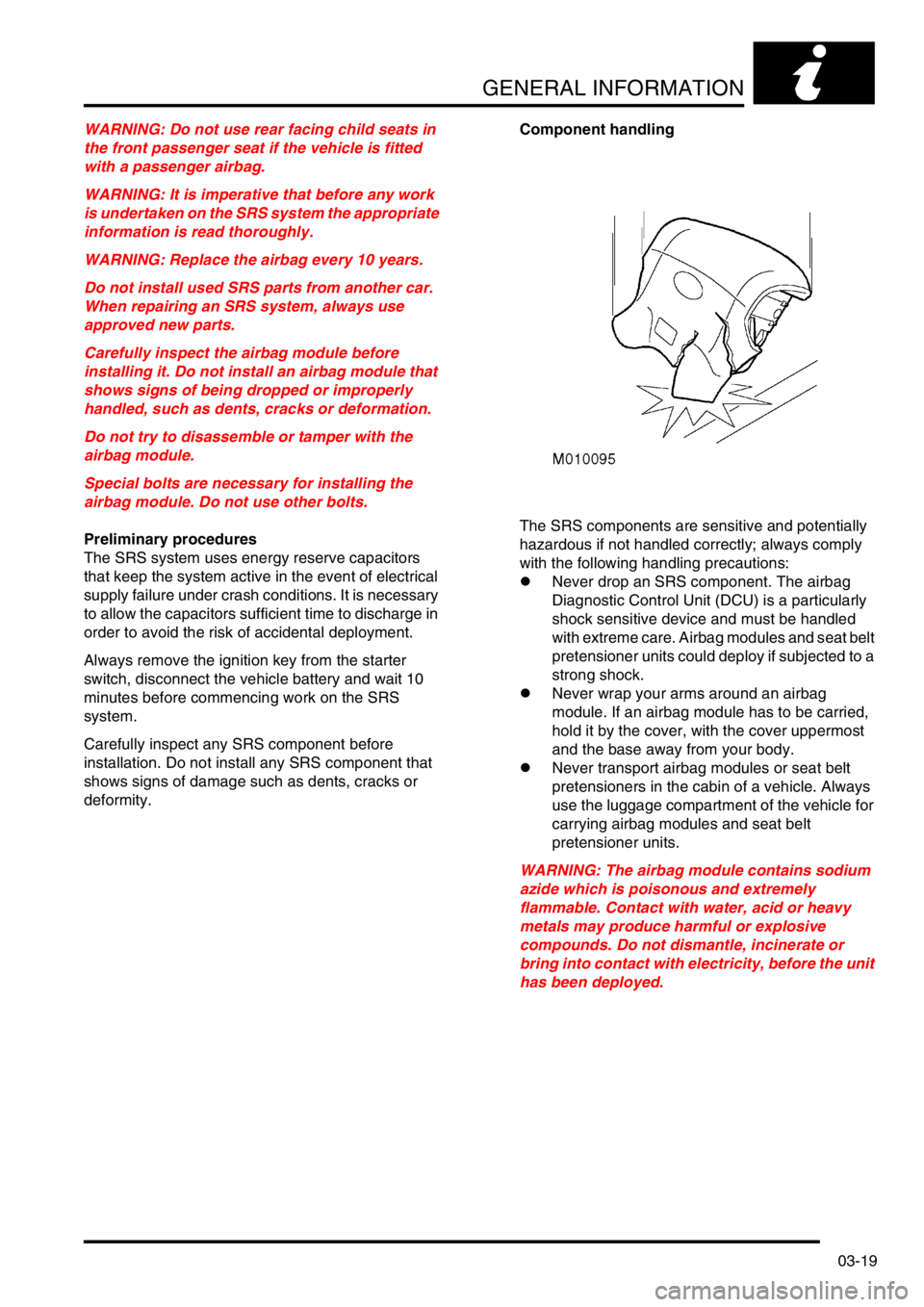
GENERAL INFORMATION
03-19
WARNING: Do not use rear facing child seats in
the front passenger seat if the vehicle is fitted
with a passenger airbag.
WARNING: It is imperative that before any work
is undertaken on the SRS system the appropriate
information is read thoroughly.
WARNING: Replace the airbag every 10 years.
Do not install used SRS parts from another car.
When repairing an SRS system, always use
approved new parts.
Carefully inspect the airbag module before
installing it. Do not install an airbag module that
shows signs of being dropped or improperly
handled, such as dents, cracks or deformation.
Do not try to disassemble or tamper with the
airbag module.
Special bolts are necessary for installing the
airbag module. Do not use other bolts.
Preliminary procedures
The SRS system uses energy reserve capacitors
that keep the system active in the event of electrical
supply failure under crash conditions. It is necessary
to allow the capacitors sufficient time to discharge in
order to avoid the risk of accidental deployment.
Always remove the ignition key from the starter
switch, disconnect the vehicle battery and wait 10
minutes before commencing work on the SRS
system.
Carefully inspect any SRS component before
installation. Do not install any SRS component that
shows signs of damage such as dents, cracks or
deformity.Component handling
The SRS components are sensitive and potentially
hazardous if not handled correctly; always comply
with the following handling precautions:
lNever drop an SRS component. The airbag
Diagnostic Control Unit (DCU) is a particularly
shock sensitive device and must be handled
with extreme care. Airbag modules and seat belt
pretensioner units could deploy if subjected to a
strong shock.
lNever wrap your arms around an airbag
module. If an airbag module has to be carried,
hold it by the cover, with the cover uppermost
and the base away from your body.
lNever transport airbag modules or seat belt
pretensioners in the cabin of a vehicle. Always
use the luggage compartment of the vehicle for
carrying airbag modules and seat belt
pretensioner units.
WARNING: The airbag module contains sodium
azide which is poisonous and extremely
flammable. Contact with water, acid or heavy
metals may produce harmful or explosive
compounds. Do not dismantle, incinerate or
bring into contact with electricity, before the unit
has been deployed.
Page 55 of 1672
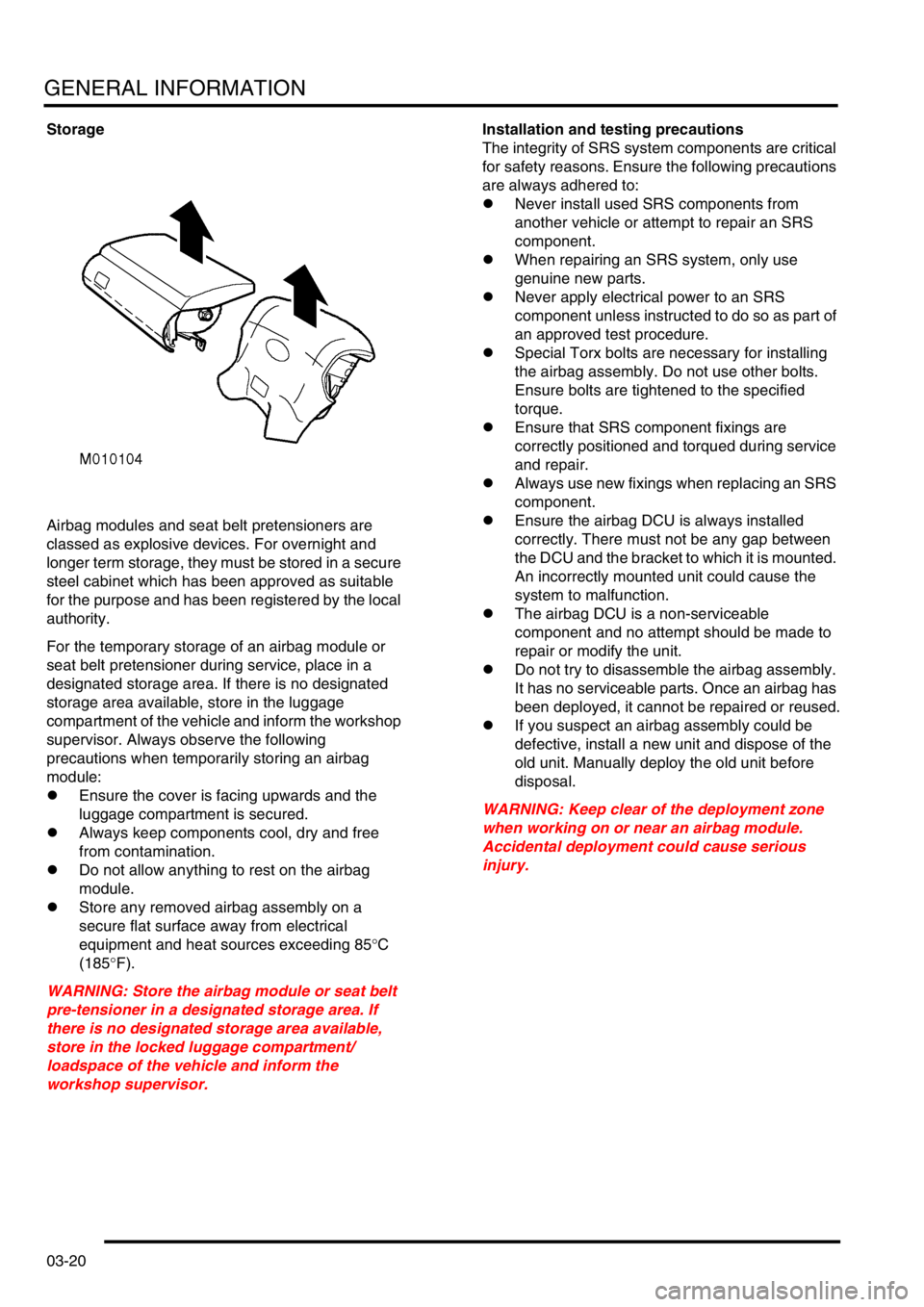
GENERAL INFORMATION
03-20
Storage
Airbag modules and seat belt pretensioners are
classed as explosive devices. For overnight and
longer term storage, they must be stored in a secure
steel cabinet which has been approved as suitable
for the purpose and has been registered by the local
authority.
For the temporary storage of an airbag module or
seat belt pretensioner during service, place in a
designated storage area. If there is no designated
storage area available, store in the luggage
compartment of the vehicle and inform the workshop
supervisor. Always observe the following
precautions when temporarily storing an airbag
module:
lEnsure the cover is facing upwards and the
luggage compartment is secured.
lAlways keep components cool, dry and free
from contamination.
lDo not allow anything to rest on the airbag
module.
lStore any removed airbag assembly on a
secure flat surface away from electrical
equipment and heat sources exceeding 85
°C
(185
°F).
WARNING: Store the airbag module or seat belt
pre-tensioner in a designated storage area. If
there is no designated storage area available,
store in the locked luggage compartment/
loadspace of the vehicle and inform the
workshop supervisor.Installation and testing precautions
The integrity of SRS system components are critical
for safety reasons. Ensure the following precautions
are always adhered to:
lNever install used SRS components from
another vehicle or attempt to repair an SRS
component.
lWhen repairing an SRS system, only use
genuine new parts.
lNever apply electrical power to an SRS
component unless instructed to do so as part of
an approved test procedure.
lSpecial Torx bolts are necessary for installing
the airbag assembly. Do not use other bolts.
Ensure bolts are tightened to the specified
torque.
lEnsure that SRS component fixings are
correctly positioned and torqued during service
and repair.
lAlways use new fixings when replacing an SRS
component.
lEnsure the airbag DCU is always installed
correctly. There must not be any gap between
the DCU and the bracket to which it is mounted.
An incorrectly mounted unit could cause the
system to malfunction.
lThe airbag DCU is a non-serviceable
component and no attempt should be made to
repair or modify the unit.
lDo not try to disassemble the airbag assembly.
It has no serviceable parts. Once an airbag has
been deployed, it cannot be repaired or reused.
lIf you suspect an airbag assembly could be
defective, install a new unit and dispose of the
old unit. Manually deploy the old unit before
disposal.
WARNING: Keep clear of the deployment zone
when working on or near an airbag module.
Accidental deployment could cause serious
injury.
Page 56 of 1672
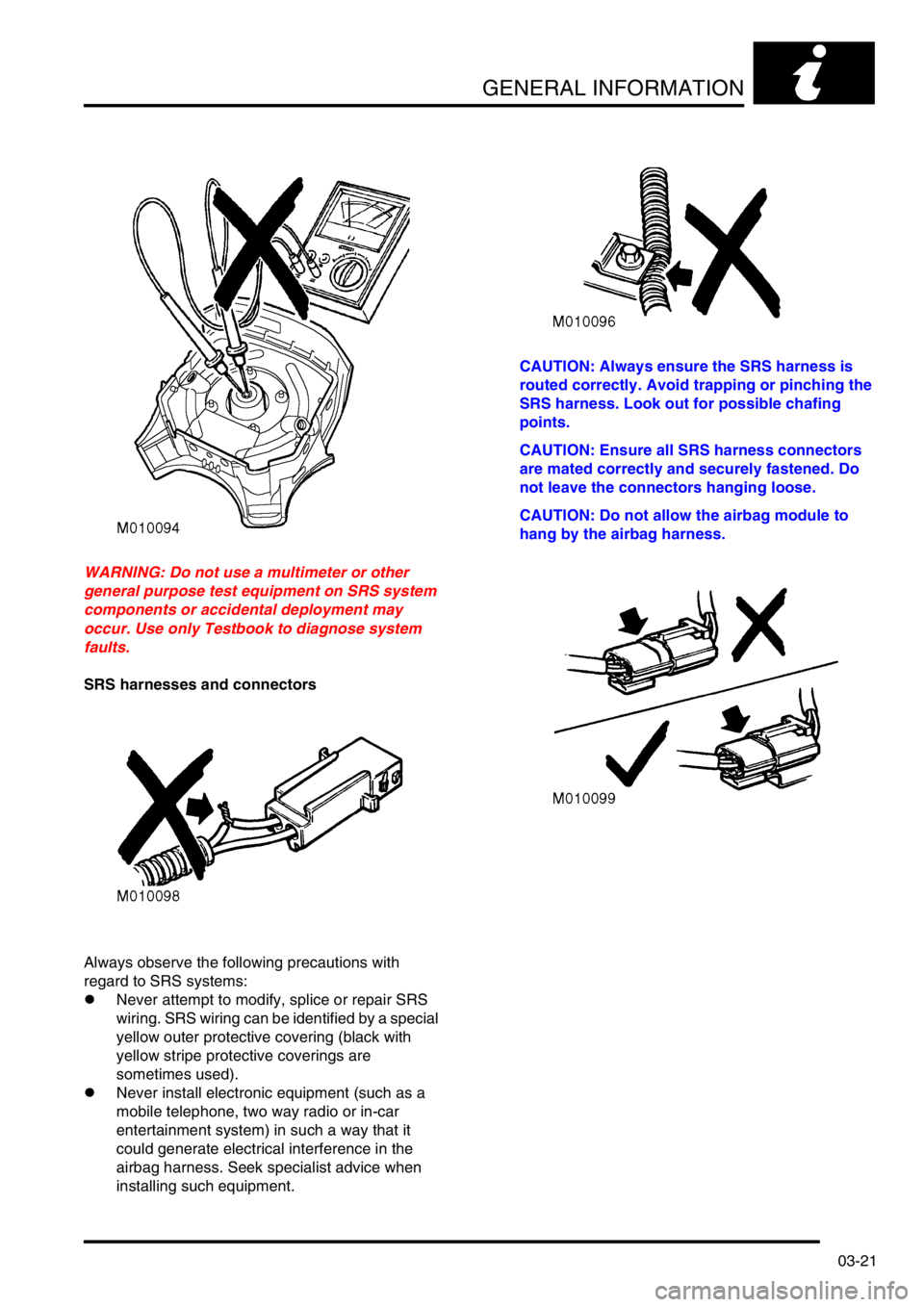
GENERAL INFORMATION
03-21
WARNING: Do not use a multimeter or other
general purpose test equipment on SRS system
components or accidental deployment may
occur. Use only Testbook to diagnose system
faults.
SRS harnesses and connectors
Always observe the following precautions with
regard to SRS systems:
lNever attempt to modify, splice or repair SRS
wiring. SRS wiring can be identified by a special
yellow outer protective covering (black with
yellow stripe protective coverings are
sometimes used).
lNever install electronic equipment (such as a
mobile telephone, two way radio or in-car
entertainment system) in such a way that it
could generate electrical interference in the
airbag harness. Seek specialist advice when
installing such equipment.CAUTION: Always ensure the SRS harness is
routed correctly. Avoid trapping or pinching the
SRS harness. Look out for possible chafing
points.
CAUTION: Ensure all SRS harness connectors
are mated correctly and securely fastened. Do
not leave the connectors hanging loose.
CAUTION: Do not allow the airbag module to
hang by the airbag harness.
Page 57 of 1672
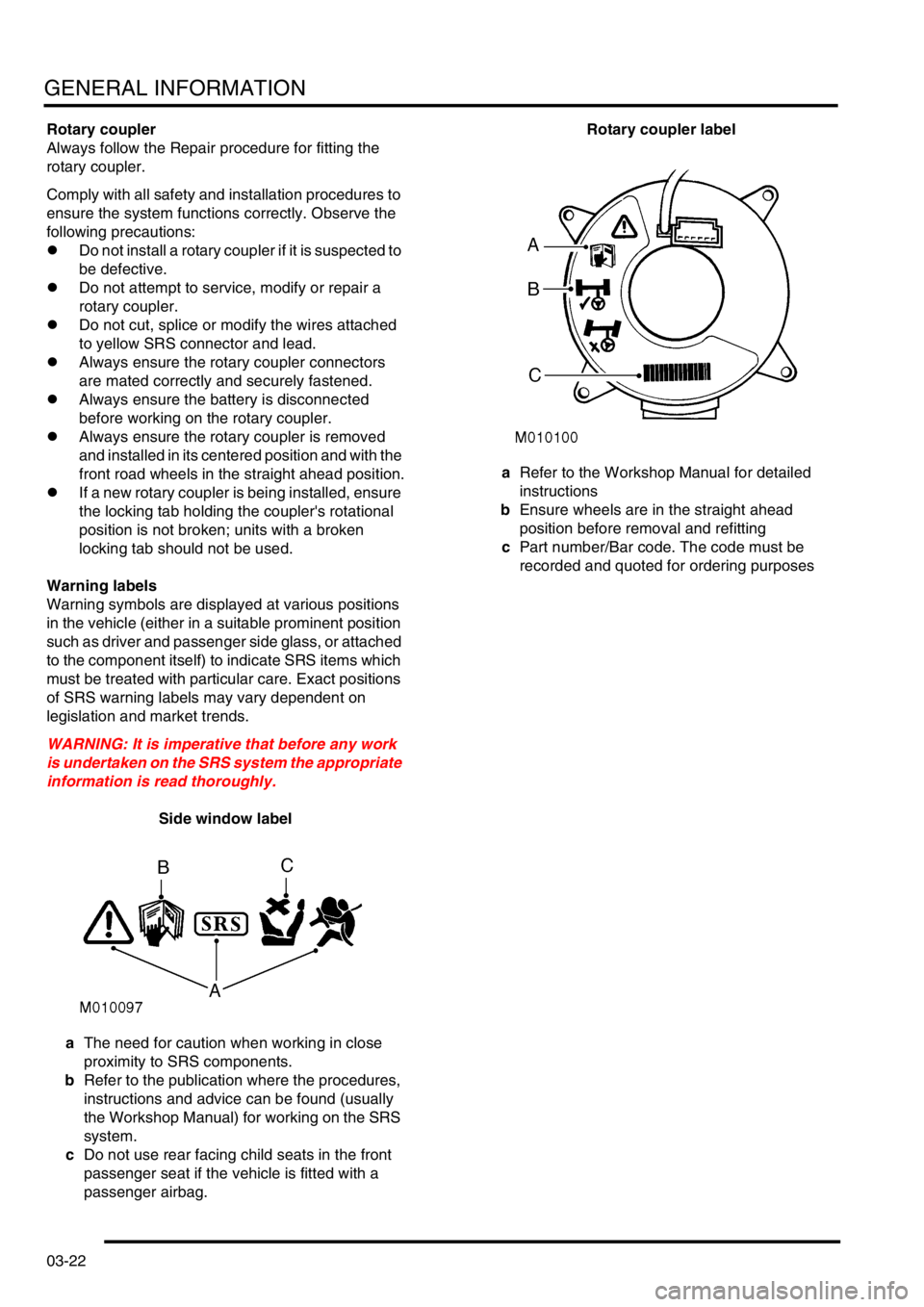
GENERAL INFORMATION
03-22
Rotary coupler
Always follow the Repair procedure for fitting the
rotary coupler.
Comply with all safety and installation procedures to
ensure the system functions correctly. Observe the
following precautions:
lDo not install a rotary coupler if it is suspected to
be defective.
lDo not attempt to service, modify or repair a
rotary coupler.
lDo not cut, splice or modify the wires attached
to yellow SRS connector and lead.
lAlways ensure the rotary coupler connectors
are mated correctly and securely fastened.
lAlways ensure the battery is disconnected
before working on the rotary coupler.
lAlways ensure the rotary coupler is removed
and installed in its centered position and with the
front road wheels in the straight ahead position.
lIf a new rotary coupler is being installed, ensure
the locking tab holding the coupler's rotational
position is not broken; units with a broken
locking tab should not be used.
Warning labels
Warning symbols are displayed at various positions
in the vehicle (either in a suitable prominent position
such as driver and passenger side glass, or attached
to the component itself) to indicate SRS items which
must be treated with particular care. Exact positions
of SRS warning labels may vary dependent on
legislation and market trends.
WARNING: It is imperative that before any work
is undertaken on the SRS system the appropriate
information is read thoroughly.
Side window label
aThe need for caution when working in close
proximity to SRS components.
bRefer to the publication where the procedures,
instructions and advice can be found (usually
the Workshop Manual) for working on the SRS
system.
cDo not use rear facing child seats in the front
passenger seat if the vehicle is fitted with a
passenger airbag.Rotary coupler label
aRefer to the Workshop Manual for detailed
instructions
bEnsure wheels are in the straight ahead
position before removal and refitting
cPart number/Bar code. The code must be
recorded and quoted for ordering purposes
Page 58 of 1672
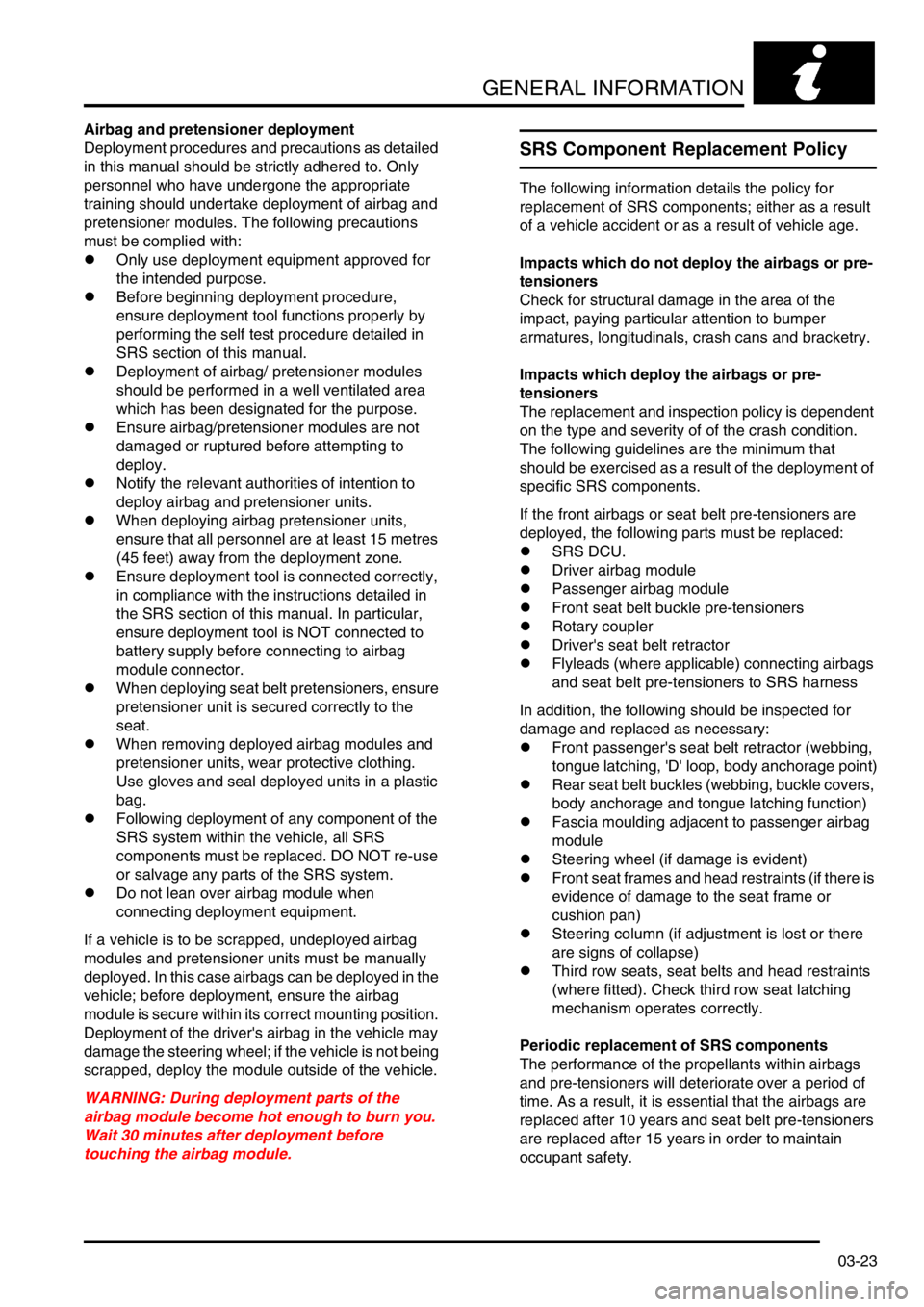
GENERAL INFORMATION
03-23
Airbag and pretensioner deployment
Deployment procedures and precautions as detailed
in this manual should be strictly adhered to. Only
personnel who have undergone the appropriate
training should undertake deployment of airbag and
pretensioner modules. The following precautions
must be complied with:
lOnly use deployment equipment approved for
the intended purpose.
lBefore beginning deployment procedure,
ensure deployment tool functions properly by
performing the self test procedure detailed in
SRS section of this manual.
lDeployment of airbag/ pretensioner modules
should be performed in a well ventilated area
which has been designated for the purpose.
lEnsure airbag/pretensioner modules are not
damaged or ruptured before attempting to
deploy.
lNotify the relevant authorities of intention to
deploy airbag and pretensioner units.
lWhen deploying airbag pretensioner units,
ensure that all personnel are at least 15 metres
(45 feet) away from the deployment zone.
lEnsure deployment tool is connected correctly,
in compliance with the instructions detailed in
the SRS section of this manual. In particular,
ensure deployment tool is NOT connected to
battery supply before connecting to airbag
module connector.
lWhen deploying seat belt pretensioners, ensure
pretensioner unit is secured correctly to the
seat.
lWhen removing deployed airbag modules and
pretensioner units, wear protective clothing.
Use gloves and seal deployed units in a plastic
bag.
lFollowing deployment of any component of the
SRS system within the vehicle, all SRS
components must be replaced. DO NOT re-use
or salvage any parts of the SRS system.
lDo not lean over airbag module when
connecting deployment equipment.
If a vehicle is to be scrapped, undeployed airbag
modules and pretensioner units must be manually
deployed. In this case airbags can be deployed in the
vehicle; before deployment, ensure the airbag
module is secure within its correct mounting position.
Deployment of the driver's airbag in the vehicle may
damage the steering wheel; if the vehicle is not being
scrapped, deploy the module outside of the vehicle.
WARNING: During deployment parts of the
airbag module become hot enough to burn you.
Wait 30 minutes after deployment before
touching the airbag module.
SRS Component Replacement Policy
The following information details the policy for
replacement of SRS components; either as a result
of a vehicle accident or as a result of vehicle age.
Impacts which do not deploy the airbags or pre-
tensioners
Check for structural damage in the area of the
impact, paying particular attention to bumper
armatures, longitudinals, crash cans and bracketry.
Impacts which deploy the airbags or pre-
tensioners
The replacement and inspection policy is dependent
on the type and severity of of the crash condition.
The following guidelines are the minimum that
should be exercised as a result of the deployment of
specific SRS components.
If the front airbags or seat belt pre-tensioners are
deployed, the following parts must be replaced:
lSRS DCU.
lDriver airbag module
lPassenger airbag module
lFront seat belt buckle pre-tensioners
lRotary coupler
lDriver's seat belt retractor
lFlyleads (where applicable) connecting airbags
and seat belt pre-tensioners to SRS harness
In addition, the following should be inspected for
damage and replaced as necessary:
lFront passenger's seat belt retractor (webbing,
tongue latching, 'D' loop, body anchorage point)
lRear seat belt buckles (webbing, buckle covers,
body anchorage and tongue latching function)
lFascia moulding adjacent to passenger airbag
module
lSteering wheel (if damage is evident)
lFront seat frames and head restraints (if there is
evidence of damage to the seat frame or
cushion pan)
lSteering column (if adjustment is lost or there
are signs of collapse)
lThird row seats, seat belts and head restraints
(where fitted). Check third row seat latching
mechanism operates correctly.
Periodic replacement of SRS components
The performance of the propellants within airbags
and pre-tensioners will deteriorate over a period of
time. As a result, it is essential that the airbags are
replaced after 10 years and seat belt pre-tensioners
are replaced after 15 years in order to maintain
occupant safety.
Page 456 of 1672

ENGINE MANAGEMENT SYSTEM - TD5
REPAIRS 18-1-63
Switch - cruise control (set/resume)
$% 19.75.33
Remove
1.Remove the key from the starter switch.
Disconnect both battery leads, negative lead
first. Wait ten minutes before starting work.
2.Remove driver's airbag module.
+ RESTRAINT SYSTEMS, REPAIRS,
Airbag module - drivers.
3.Release remote control switches multiplug and
leads from steering wheel base.
4.Disconnect remote control switches multiplug
from harness.
5.Remove 2 screws securing remote control
switches to steering wheel base.
6.Release and remove remote control switches
from steering wheel.
Refit
1.Fit remote control switches to steering wheel
and secure with screws.
2.Connect remote control switches multiplug to
harness.
3.Secure leads and multiplug to base of steering
wheel.
4.Fit driver's airbag module.
+ RESTRAINT SYSTEMS, REPAIRS,
Airbag module - drivers.
Switch - clutch
$% 19.75.34
Remove
1.Disconnect the multiplug from the clutch switch.
2.Position a container below the clutch switch to
collect the fluid.
3.Unscrew and remove the clutch switch.
CAUTION: Always fit plugs to open
connections to prevent contamination.
Refit
1.Fit the clutch switch and tighten to 10 Nm (7
lbf.ft).
2.Connect the multiplug.
3.Bleed the clutch hydraulic system.
+ CLUTCH - Td5, ADJUSTMENTS,
Clutch hydraulic system - bleed.